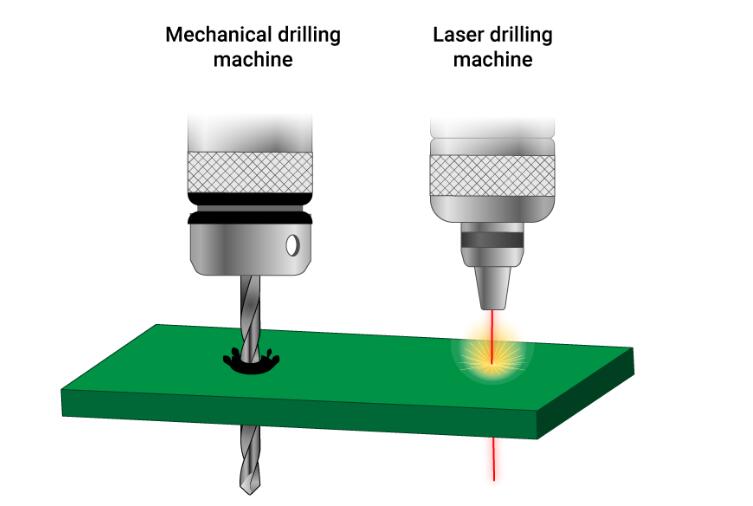A circuit board drill is a complex mechanical component used to manufacture printed circuit boards (PCBs). When making a PCB, accuracy is everything. Therefore, professional machinery is used to ensure accuracy, quality, and performance.

Two common drilling methods for circuit board
1. Mechanical drilling
The accuracy of mechanical drills is low, but they are easy to execute. This drilling technology enables the drill bit. The minimum hole diameter that these drill bits can drill is approximately 6 mils (0.006 inches).
Limitations of Mechanical Drilling
When used in softer materials such as FR4, mechanical drills can be used for 800 impacts. For materials with high density, the lifespan will be reduced to 200 counts. If this is ignored, it can lead to incorrect holes, which can lead to circuit board scrapping.
2. Laser drilling
Laser drills can drill smaller holes. Laser drilling is a non-contact process where the workpiece and tool do not come into contact with each other. Laser beams are used to remove circuit board materials and create precise holes, allowing effortless control of drilling depth. Laser technology is used to easily drill through holes of controlled depth, which can accurately drill holes with a minimum diameter of 2 mils (0.002 ").
Limitations of laser drilling
The circuit board is made of copper, glass fiber, and resin, which have different optical properties, making it difficult for laser beams to effectively burn through the circuit board. In the case of laser drilling, the cost of this process is also relatively high.
Circuit board drilling process
After the lamination process, the laminate is loaded onto the outlet material panel on the drilling machine. The export material reduces the formation of burrs. Burr is the protruding part of copper formed when the drilling shaft penetrates the plate. At the top of the panel, more stacks were loaded and carefully aligned. Finally, place a sheet of aluminum foil on the entire stack. The aluminum foil avoids entrance burrs and also dissipates the heat generated by the rapidly rotating drill bit. Once the required number of holes are drilled, the circuit board will be sent for deburring and decontamination treatment.
Since the quality of drilling is a key aspect, it is necessary to consider the geometric shape of the tool. High-speed steel (HSS) and tungsten carbide WC are commonly used drill bit materials for composite material drilling. During the processing of glass fiber reinforced polymer (GFRP), hard alloy tools can provide longer tool life. Hard alloy drill bits are commonly used for circuit board drilling.
During the circuit board drilling process, many different types of holes will be drilled. These holes include through holes (such as through holes, buried holes, blind holes, and micropores), component holes, and mechanical holes.
Types of circuit board drill bits
The drills for circuit drilling include straight shank Fried Dough Twists drills, fixed shank Fried Dough Twists drills and fixed shank undercut drills. 1) Straight handle Fried Dough Twists drills are mostly used for single-head drilling machines to drill simple printed boards or single panels, and the drilling depth can reach 10 times the drill diameter. When the substrate layer is not high, using a drill sleeve can avoid drilling deviation.
2) At present, most of the CNC drilling machines are used, which use fixed shank drill bits made of hard alloy, characterized by the ability to automatically replace drill bits. High positioning accuracy, no need to use drill sleeves. Large helix angle, fast chip removal speed, suitable for high-speed cutting. Within the full-length range of the chip removal groove, the diameter of the drill bit is an inverted cone, resulting in less friction with the hole wall during drilling and higher drilling quality. The common drill stem diameters are 3.00mm and 3.175mm.
Circuit board drill bits are generally made of hard alloy, as epoxy glass cloth-coated copper foil plates have particularly fast wear on the cutting tools. It has the characteristics of high hardness, high wear resistance, high strength, bending resistance, bending resistance, and long tool life.